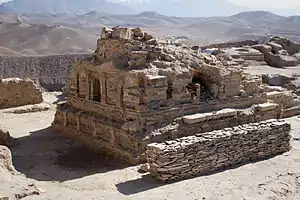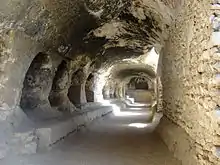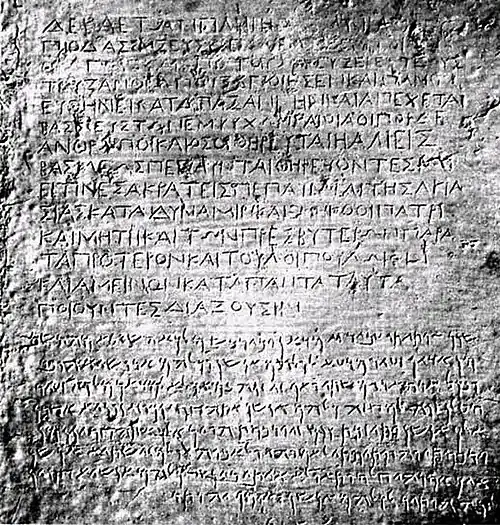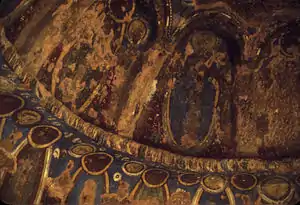Buddhism in Afghanistan
Buddhism in Afghanistan was one of the major religious forces in the region during pre-Islamic era. The religion was widespread south of the Hindu Kush mountains. Buddhism first arrived in Afghanistan in 305 BC when the Greek Seleucid Empire made an alliance with the Indian Maurya Empire. The resulting Greco-Buddhism flourished under the Greco-Bactrian Kingdom (250 BC-125 BC) and the later Indo-Greek Kingdom (180 BC - 10 AD) in modern northern Pakistan and Afghanistan. Greco-Buddhism reached its height under the Kushan Empire, which used the Greek alphabet to write its Bactrian language.


Lokaksema (c. 178 AD), who travelled to the Chinese capital of Luoyang and was the first translator of Mahayana Buddhist scriptures into Chinese,[1] and Mahadharmaraksita who, according to the Mahavamsa (Chap. XXIX[2]), led 30,000 Buddhist monks from "the Greek city of Alasandra" (Alexandria of the Caucasus, around 150 km north of today's Kabul in Afghanistan), to Sri Lanka for the dedication of the Great Stupa in Anuradhapura. The Greco-Bactrian King Menander I, (Pali) "Milinda," ruled 165 BC - 135 BC, was a renowned patron of Buddhism immortalized in the Buddhist text the Milinda Panha.
The famous Persian Buddhist monastery in Balkh in northern Afghanistan, known as Nava Vihara ("New Monastery"), functioned as the center of Central Asia Buddhist learning for centuries.
The Buddhist religion in Afghanistan started fading with the Muslim conquest in the 7th century but finally ended during the Ghaznavids in the 11th century.[3]
History
The territory within the borders of Afghanistan has seen many cultural and religious shifts over the centuries. The geographical position of the area between the Middle East, South Asian, and Central Asian cultures, and the proximity to the famous Silk Road (connecting East Asian and Mediterranean civilizations, and others in between), have been major drivers of local historical and cultural developments. One major influence was the conquest of the area by Alexander the Great, which incorporated the area for a time into the Hellenistic World, and resulted in a strong Hellenistic influence on Buddhist religious art in that region. In 305 BC, the Seleucid Empire made an alliance with the Indian Maurya Empire. The Mauryans brought Buddhism from India and controlled the area south of the Hindu Kush until about 185 BC when they were overthrown.
Alexander took these away from the Aryans and established settlements of his own, but Seleucus Nicator gave them to Sandrocottus (Chandragupta), upon terms of intermarriage and of receiving in exchange 500 elephants.[4]
— Strabo, 64 BC – 24 AD

At the time of these developments, most of the area belonged to the kingdoms of Bactria and Sogdiana, including the Scythians, followed Buddhism until the arrival of Islam.
Many monuments testify to the Buddhist culture in present-day Afghanistan. Greek cultural and artistic influence in the region can be researched under Buddhist art and Greco-Buddhism. Additional historical detail can be researched under Pre Islamic Hindu and Buddhist heritage of Afghanistan and Hinduism in Afghanistan.
Soon after the Sassanian Persian dynasty fell to the Muslims (in 651 AD), the Nava Vihara monastery in Balkh came under Muslim rule (in 663 AD), but the monastery continued to function for at least another century. In 715 AD, after an insurrection in Balkh was crushed by the Abbasid Caliphate, many Persian Buddhist monks fled east along the Silk Road to the Buddhist Kingdom of Khotan, which spoke a related Eastern Iranian language, and onward into China. Nava Vihara's hereditary administrators, the Persian Barmakids, converted from Buddhism to Islam after the monastery's conquest and became powerful viziers under the Abbassid caliphs of Baghdad. The last of the family's line of viziers, Ja'far ibn Yahya, is a protagonist in many tales from the Arabian Nights. In folktales and popular culture Ja'far has been associated with a knowledge of mysticism, sorcery, and traditions lying outside the realm of Islam.
The Buddhist religion survived the Islamic conquest of Afghanistan by the Umayyads and rule by the Abbasid Caliphate. Buddhism in Afghanistan was effectively removed by the Saffarids, Ghaznavids, and Ghurids.[5][6]
Archaeological finds

Bamiyan monastery library
One of the early Buddhist schools, the Mahāsāṃghika-Lokottaravāda, were known to be prominent in the area of Bamiyan. The Chinese Buddhist monk Xuanzang visited a Lokottaravāda monastery in the 7th century CE, at Bamiyan, Afghanistan, and this monastery site has since been rediscovered by archaeologists.[7] Birchbark and palm leaf manuscripts of texts in this monastery's collection, including Mahāyāna sūtras, have been discovered at the site, and these are now located in the Schøyen Collection. Some manuscripts are in the Gāndhārī language and Kharoṣṭhī script, while others are in Sanskrit and written in forms of the Gupta script. Manuscripts and fragments that have survived from this monastery's collection include the following source texts:[7]
- Pratimokṣa Vibhaṅga of the Mahāsāṃghika-Lokottaravāda (MS 2382/269)
- Mahāparinirvāṇa Sūtra, a sūtra from the Āgamas (MS 2179/44)
- Caṃgī Sūtra, a sūtra from the Āgamas (MS 2376)
- Vajracchedikā Prajñāpāramitā Sūtra, a Mahāyāna sūtra (MS 2385)
- Bhaiṣajyaguru Sūtra, a Mahāyāna sūtra (MS 2385)
- Śrīmālādevī Siṃhanāda Sūtra, a Mahāyāna sūtra (MS 2378)
- Pravāraṇa Sūtra, a Mahāyāna sūtra (MS 2378)
- Sarvadharmapravṛttinirdeśa Sūtra, a Mahāyāna sūtra (MS 2378)
- Ajātaśatrukaukṛtyavinodana Sūtra, a Mahāyāna sūtra (MS 2378)
- Śāriputrābhidharma Śāstra (MS 2375/08)
Buddhist relics
In August 2010, it was reported that approximately 42 Buddhist relics have been discovered in Mes Aynak of the Logar Province in Afghanistan, which is south of Kabul. Some of these items date back to the 2nd century according to Archaeologists. Some Buddhist sites were found in Ghazni.[8] The items in Logar include two Buddhist temples (Stupas), Buddha statues, frescos, silver and gold coins and precious beads.[9][10][11]
There is a temple, stupas, beautiful rooms, big and small statues, two with the length of seven and nine meters, colorful frescos ornamented with gold and some coins... Some of the relics date back to the fifth century (AD)... We have come across signs that there are items maybe going back to the era before Christ or prehistory... We need foreign assistance to preserve these and their expertise to help us with further excavations.[12]
— Mohammad Nader Rasouli, Afghan Archaeological Department
Jain Relics
Two rare Jain bronze relics have been found in Afghanistan.[13] The 3rd/4th century c.e. Jain text Vasudevahindi mentions Jain merchants travelling overseas to Java, China and central Asia. Two additional Jain images have been reported in Afghanistan, a marble Padmasan image, and an image in the private collection of the king.[14]
Buddhist sites
- Tepe Narenj
- Bamiyan
- Tapa Sardar
- Takht-i-Rustam
- Mes aynak
- Tepe Kafiriyat
Gallery
 Cave system, stupa and monastery at Samangan, Takht-i-rustam
Cave system, stupa and monastery at Samangan, Takht-i-rustam The Bodhisattva and Chandeka, Hadda, 5th century CE
The Bodhisattva and Chandeka, Hadda, 5th century CE

 Wardak Vase in British Museum
Wardak Vase in British Museum
 Bamiyan Grotto paintings
Bamiyan Grotto paintings Afghanistan, stupa TK23, hadda site, tapa-kalan monastery, 4th-5th cent
Afghanistan, stupa TK23, hadda site, tapa-kalan monastery, 4th-5th cent Afghanistan, capital of stupas, from the site of hadda, chakhil-i-ghoundi monastery, II-III century
Afghanistan, capital of stupas, from the site of hadda, chakhil-i-ghoundi monastery, II-III century Afghanistan, stairway of stupas, from the site of hadda, chakhil-i-ghoundi monastery, II-III cent
Afghanistan, stairway of stupas, from the site of hadda, chakhil-i-ghoundi monastery, II-III cent Court with stupa, after excavation, Ali Masjid
Court with stupa, after excavation, Ali Masjid-_Landschaft_-_Annemarie_Schwarzenbach_-_SLA-Schwarzenbach-A-5-21-001.jpg.webp) Shewaki stupa
Shewaki stupa General view of Stupa No. 6, with Buddha images
General view of Stupa No. 6, with Buddha images Reconstitution of the Buddhist monastery of Ahin Posh Tepe, Afghanistan
Reconstitution of the Buddhist monastery of Ahin Posh Tepe, Afghanistan.jpg.webp) Grey schist figure of Buddha, Auckland Museum
Grey schist figure of Buddha, Auckland Museum Afghanistan Buddhist art
Afghanistan Buddhist art Begram Decorative plaque from a chair or throne, ivory, room 13, c.100 BCE
Begram Decorative plaque from a chair or throne, ivory, room 13, c.100 BCE
See also
References
- Foltz, Religions of the Silk Road, p. 46
- Full text of the Mahavamsa Click chapter XXIX
- Berzin, Alexander (December 2006). "History of Buddhism in Afghanistan". Retrieved June 5, 2016.
- Nancy Hatch Dupree / Aḥmad ʻAlī Kuhzād (1972). "An Historical Guide to Kabul – The Name". American International School of Kabul. Archived from the original on August 30, 2010. Retrieved September 18, 2010.
- Amy Romano (2003). A Historical Atlas of Afghanistan (illustrated ed.). The Rosen Publishing Group. p. 25. ISBN 0-8239-3863-8. Retrieved 18 September 2011.
- Steven Otfinoski (2004). Afghanistan (illustrated ed.). Infobase Publishing. p. 6. ISBN 0-8160-5056-2. Retrieved 18 September 2011.
- "Schøyen Collection: Buddhism". Archived from the original on 10 June 2012. Retrieved 23 June 2012.
- Embassy of the United States, Kabul. Ghazni 10.26.2011
- Embassy of the United States, Kabul. Mes Aynak 10.29.2011
- "42 Buddhist relics discovered in Logar". Maqsood Azizi. Pajhwok Afghan News. Aug 18, 2010. Archived from the original on 2010-03-17. Retrieved 2010-08-23.
- "Afghan archaeologists find Buddhist site as war rages". Sayed Salahuddin. News Daily. Aug 17, 2010. Archived from the original on 2010-08-18. Retrieved 2010-08-16.
- "Buddhist remains found in Afghanistan". Press TV. Aug 17, 2010. Retrieved 2010-08-16.
- [Evidence of Jainism in Afghanistan and Kashmir in Ancient Times, Pratapaditya Pal, Bulletin of the Asia Institute, New Series, Vol. 21 (2007), pp. 25-33]
- [Archaeological Remains of Jainism in West Pakistan & Afghanistan, Klaus Fischer, The Voice of Ahinsa. Lord Mahavira Special Number" (Vol. VI, No. 3-4, March–April 1956, pp. 84f., continued at p. 81]
External links
| Wikimedia Commons has media related to Buddhism in Afghanistan. |